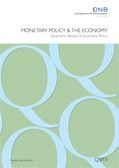Monetary Policy and the Economy Q4/13
 OeNB
OeNB
- published:
- December 2013.
 OeNB
OeNB
Monetary Policy and the Economy Q4/13 (PDF, 1.8 MB) December 2013.
Austrian Economy Recovers from Two-Year Weak Patch (PDF, 643 kB) Fenz, Schneider – Monetary Policy and the Economy Q4/13 en Dec 31, 2013, 12:00:00 AM
Are Recent Increases of Residential Property Prices in Vienna and Austria Justified by Fundamentals?
(PDF, 846 kB)
Schneider.
Schneider – Monetary Policy and the Economy Q4/13
Residential property prices in Vienna have risen sharply since 2005 and to a lesser degree
throughout Austria as well. This paper assesses whether the upward movement is justified by
fundamental factors or whether it is exaggerated, using a fundamental residential property
price indicator for Vienna and Austria to identify deviations between actual and fundamental
real estate prices.
The indicator consists of seven subindicators that address a variety of perspectives, including
those related to households, investors and systemic factors. For Vienna, the indicator points to
an increasing degree of overvaluation in property prices (by 20% in the second quarter of
2013). The primary driver behind this trend, which has recently experienced an especially pronounced
surge, is the relative real estate price (compared to rentals, consumer prices and
construction costs), which is only weakly mitigated by the increased affordability of home
ownership. Of note, the overvaluation evident in the indicator does not suggest that an abrupt
price correction will occur in the near future. Rather, such imbalances may subside gradually,
as happened in the wake of the price hikes experienced in the early 1990s. For Austria overall,
the indicator points to a persistent 6% undervaluation, despite a recent uptick in prices.
Diminishing loan growth and declining household indebtedness suggest that a high percentage
of equity financing is being used in property investments. At present, therefore, the recent
increases of residential property prices in Vienna and Austria do not pose a serious threat to
financial stability.
en
residential property prices, indicator, Austria, Vienna
G12, R31
Jan 20, 2014, 12:00:00 AM
The Austrian System of Individual Pension Accounts – An Unfinished Symphony
(PDF, 308 kB)
Knell.
Knell – Monetary Policy and the Economy Q4/13
The new Austrian pension system based on individual accounts is a clear improvement over
the former system. A serious shortcoming of the new system, however, is that it does not react to demographic changes, in particular to increases in life expectancy. I contrast the Austrian and the Swedish pension account systems to demonstrate how and why the latter is able to react to demographic changes. I also show how the Austrian system could be adapted to include such an automatic adjustment mechanism. In particular, this would require a continuous modification of the “key formula” 80/65/45 (80% replacement rate after 45 contribution years at a retirement age of 65). In a next step I argue why an increase in the average retirement age seems to be the most appropriate and viable reaction to the increase in life expectancy and why alternative adjustment policies have their limits. Finally, I discuss some commonly expressed objections to this adjustment strategy. I also sketch how a system of individual accounts could be amended in order to take some of these objections into account.
en
pension system, demographic change, life expectancy
H55, J1, J26
Jan 20, 2014, 12:00:00 AM